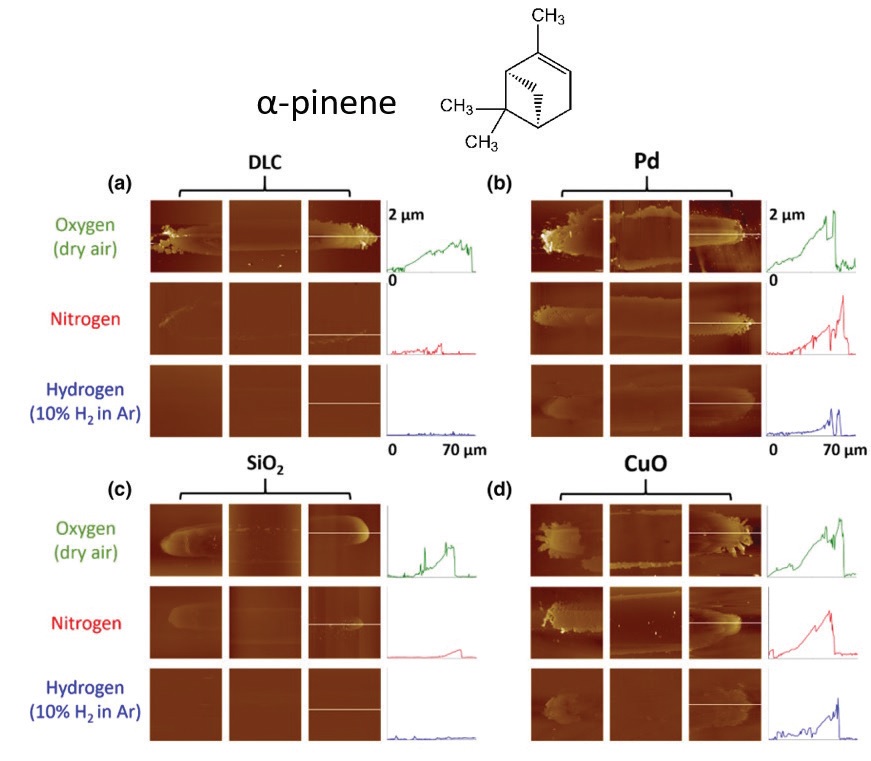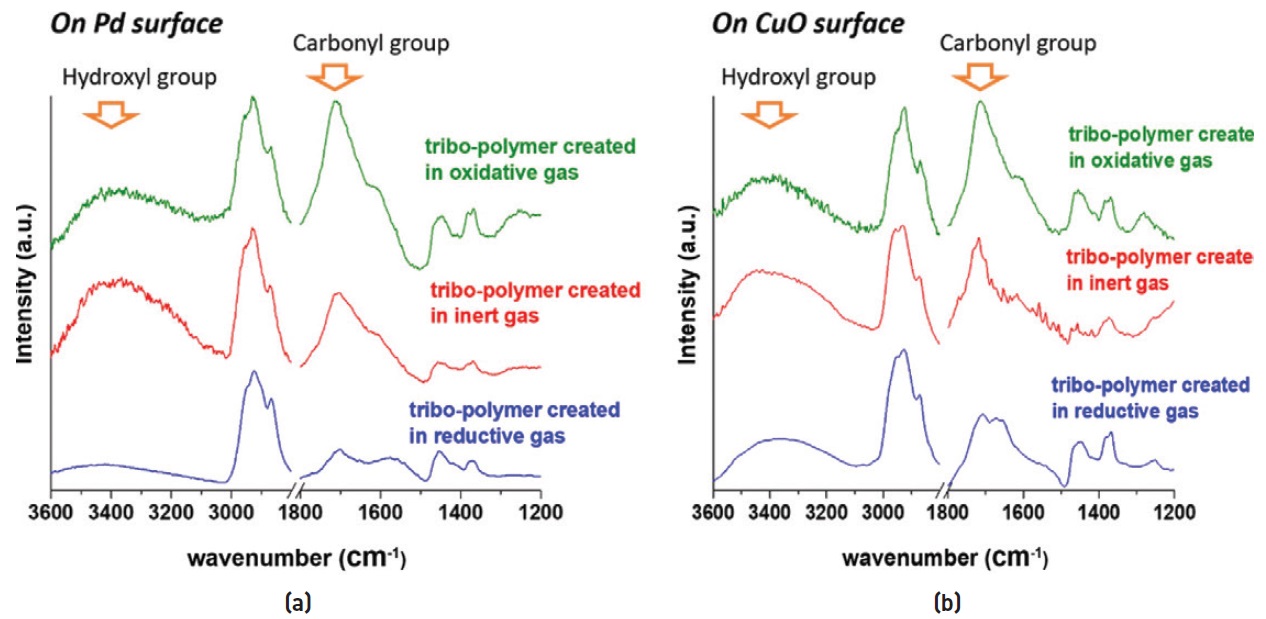Controlling shear-induced tribochemistry
Drs. Wilfred T. Tysoe & Nicholas D. Spencer | TLT Cutting Edge June 2019
The reactivity of the substrate and the nature of the environment can influence the rates of shear-induced tribochemical reactions.
We recently discussed how the strength of the interaction between adsorbed molecules and the sliding counterface can accelerate the rates of tribochemical reactions (
1). However, the force exerted on the reacting molecule also could depend on how strongly it is anchored to the surface and therefore also might be influenced by the presence of adsorbed gases.
STLE-member professor Seong Kim of the department of chemical engineering at the Pennsylvania State University and his students, Xin He and Austin Pollock, have investigated these effects by studying the tribochemically induced polymerization of α-pinene (
depicted at the top of Figure 1) during reciprocating sliding on reactive (palladium [Pd] and cuprous oxide [CuO]) and unreactive (diamond-like carbon [DLC] and silica) surfaces in the presence of inert (dry nitrogen), oxidative (dry oxygen) and reductive (hydrogen in argon) environments (
2). They measured the extent of tribo-polymer formation from the volume of product determined by an atomic force microscope (AFM) as shown in the images in Figure 1. The thicknesses of the resulting tribofilms are plotted at the right of each image, and show that the surfaces on which α-pinene is expected to adsorb strongly (Pd and CuO) are more reactive than on those where it adsorbs weakly (DLC and silica).
 Figure 1. Tapping-mode AFM images of α-pinene (shown at the top of the figure) tribo-polymers accumulated at both ends and in the middle of the slide track after 400 cycles of reciprocating sliding with a silicon nitride ball at a Hertzian contact pressure of 0.5 GPa in oxidative (top), inert (middle) and reductive (bottom) gases containing 1.5 Torr of α-pinene vapor. The image size is 70 µm × 70 µm and the height full scale is 2 µm. The cross-section line profile (white line) of the right end is plotted in the right side of images. (Published with permission from Ref. 2.)
Figure 1. Tapping-mode AFM images of α-pinene (shown at the top of the figure) tribo-polymers accumulated at both ends and in the middle of the slide track after 400 cycles of reciprocating sliding with a silicon nitride ball at a Hertzian contact pressure of 0.5 GPa in oxidative (top), inert (middle) and reductive (bottom) gases containing 1.5 Torr of α-pinene vapor. The image size is 70 µm × 70 µm and the height full scale is 2 µm. The cross-section line profile (white line) of the right end is plotted in the right side of images. (Published with permission from Ref. 2.)
Interestingly, the extent of tribochemical reaction also increases significantly in the presence of gas-phase oxygen. Infrared spectroscopy was used to investigate the origin of this effect (
see Figure 2), which shows the spectral regions due to hydroxyl (-OH, 3050-3600 cm
-1), CH
x (~2900 cm
-1) and carbonyl (C=O, 1650-1800 cm
-1) groups. The results reveal that more carbonyls and hydroxyl species are formed in the oxidative environment than in the reductive one. The authors postulate that this is due to the dissociative adsorption of oxygen on these reactive surfaces, which promotes stronger chemisorption of α-pinene. In turn, the stronger binding to the surface enables larger forces to be exerted on the molecule, thereby accelerating the reaction rate.
 Figure 2. IR spectra of tribo-polymers of α-pinene on (a) Pd and (b) CuO substrates produced in oxidative (green), inert (red) and reductive (blue) gas environments. The micro-IR analysis was carried out for tribo-polymers accumulated at the end of the slide track after 400 cycles of reciprocating sliding with silicon nitride balls in 1.5 Torr of α-pinene vapor. (Published with permission from Ref. 2.)
Figure 2. IR spectra of tribo-polymers of α-pinene on (a) Pd and (b) CuO substrates produced in oxidative (green), inert (red) and reductive (blue) gas environments. The micro-IR analysis was carried out for tribo-polymers accumulated at the end of the slide track after 400 cycles of reciprocating sliding with silicon nitride balls in 1.5 Torr of α-pinene vapor. (Published with permission from Ref. 2.)
While more detailed work is needed, such careful, molecular-level studies point the way forward to tailoring both molecular structure and the environment to form friction- or wear-reducing films on different surfaces in a selective manner.
FOR FURTHER READING
1.
Tysoe, W.T., Spencer, N.D. (2019), “Bifunctional Lubricants Bridge the Gap,” TLT,
75, pp. 62-63.
2.
He, X., Pollock, A., Kim, S.H. (2019), “Effect of Gas Environment on Mechanochemical Reaction: A Model Study with Tribo-Polymerization of α-Pinene in Inert, Oxidative, and Reductive Gases,”
Tribology Letters,
67, p. 25.
Eddy Tysoe is a distinguished professor of physical chemistry at the University of Wisconsin-Milwaukee. You can reach him at wtt@uwm.edu.
Nic Spencer is professor of surface science and technology at the ETH Zurich, Switzerland, and editor-in-chief of STLE-affiliated Tribology Letters journal. You can reach him at nspencer@ethz.ch.